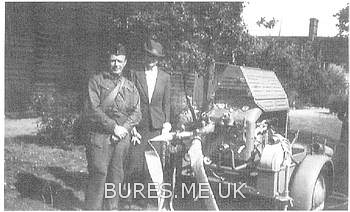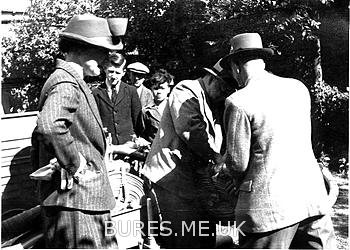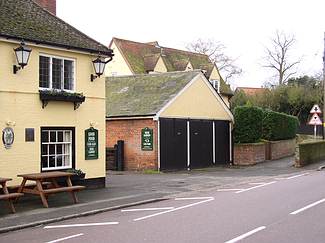|
|
The original "Bures
Fire Station" was located on land to the left of the garage,
which is located opposite the "Eight Bells Public House"
in Colchester Road |
History
of Fire Service during WW11,1939 - 1945
One problem that became
apparent during World War I was that of non-standardisation. Hydrants,
stand pipes and hose couplings were a problem when different brigades
were working together.
The Auxiliary Fire Service
was established to act as a backup or a support force to the professional
front-line service during wartime. The volunteers are trained in aspects
of fire fighting. This includes pump and ladder drills and different types
of fire situations. The AFS also trained in the pumping of water during
floods and supplying water to the community in times of emergency. Subsequently,
the Auxiliary Fire Service was formed in 1938 and was mobilised on the
1st of September 1939
However, the incendiary
bomb attacks of the winter of 1940/41 demonstrated the inadequacy of the
fire prevention services, which were still under a multiplicity of local
authorities, though coordinated by the Home Office and supported by the
Auxiliary Fire Service, the Home Office set about creating a National
Fire Service
So on 22nd May 1941 the
National Fire Service was formed to unify the whole of the country and
eliminate any operational problems.
 |
National Fire Service engine dated
1943.
Now located at Wormingford.
(The indicators on the front bumper
are to comply with modern road regulations)
|
By
1940 the village had its own complement with hose pipes, stand pipes, ladders
(from a local builder) and a lorry (on loan from Chambers Buses). Over the coming
months additional fire fighting equipment was purchased.
By July 1940 the
village achieved the ultimate possession, a trailer pump donated by a local resident,
Mr Wood.
It was held under a covenant by the Parish Council. At the time this
was a very expensive piece of equipment, Mr Wood was concerned that the village
had no protection against incendiary bombs if they should ever ignite the village
houses.
The maintenance and well being of this pump was allocated to Bill
Moody, who seemed the only one who could master all the valves and taps etc.
The
village fireman also doubled up as ARP Utility Wardens and were paid the sum of
£1.00 per year as a retainer.
During the war years the brigade was fortunate enough to avoid dealing
with any major fires, but they were judged to be 2nd best in West Suffolk.

Photo by Peter Richards
|
Trailer pump.
This was towed by a local Ford Saloon car to the scene of the fire.
Water was obtained from ponds, wells, hydrants etc
Picture taken outside Bridge House
with Mr & Mrs Thomas Wood.
Mr Wood was the Commanding officer of the Home Guard (LDV) who purchased
the pump for village use.
|

Villagers inspect the new Trailer
Pump
Mr and Mrs Wood in the foreground
|
|
 Building now used as garage in
2004
Building now used as garage in
2004 |
The National Fire Service
station was situated at the garages of the Swan Inn.
There were three buildings,
one housed the trailer pump, another a Ford Saloon car and finally
living accommodation. There were 7 part time fireman in the village
with two on duty at all times to receive fire alarm calls. These two
would then attempt to pick up a further four crew to make a full compliment.
Hopefully others would then arrive at the station to act as a reserve
crew. |
With
the ending of the war on 8th May 1945, the fire brigade was gradually disbanded.
The
Fire Station was eventually closed when it reverted back to local authority control.
All "National Fire Service" and "Auxiliary Fire Service" brigades
ceased operation by 1st April 1948. However,
this is not the end of the tale:-
In 1948, early one morning it was taken
out of its garage without any authority and whisked off to Ipswich. Mr Wood and
the Parish Council were extremely angry as a result of these actions. The Fire
Brigade at Ipswich dismissed appeals for its return stating, "...these were
government orders, all Fire Brigades and their property were now public property"
This did not go down at all well with Mr Wood. He subsequently found out
that the Head of the Fire Brigade at the Home Office had previously been
with him up at Oxford University. Mr Wood immediately sent him a letter
stating all the facts, basically saying ".........that in England,
you don't do things like that"
This had the desired effect, within a short
time an official letter arrived, stating the pump would be returned - and it did.
The pump so generously donated to the village, survived the war and now
the Home Office attempted to confiscate it, it was the parishes pride
and joy.
However,
with the coming of the County Fire Service the pump was no longer required and
it was sold for £50 to Staunch
Farm for irrigation work.
Later in its life (circa 1960`s) it was found to
be too expensive to operate. It was once again sold, this time for the brasswork
and fittings - a sad end to a fine piece of eqpt. NB:-
Dr Thomas Wood also gave the village in 1949, four and a half acres of land in
the centre of the village which we now use as the recreation ground.
Just before his death in 1950 he promised a subscription of £100 towards
the proposed addition of two bells to complete the octave in the church tower
and had undertaken to guarantee the full cost of the work - about £400
BW
Photos by Peter Richards
Colour Photo by Alan Beales
Today cover for the village emanates from Sudbury (24hr staffed), Nayland
(part time) and backed up by the Colchester (24hr staffed) Essex Fire
service
CLICK HERE for full version
Updated 14/04/2007
| ![]()

